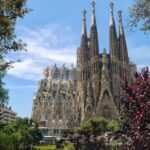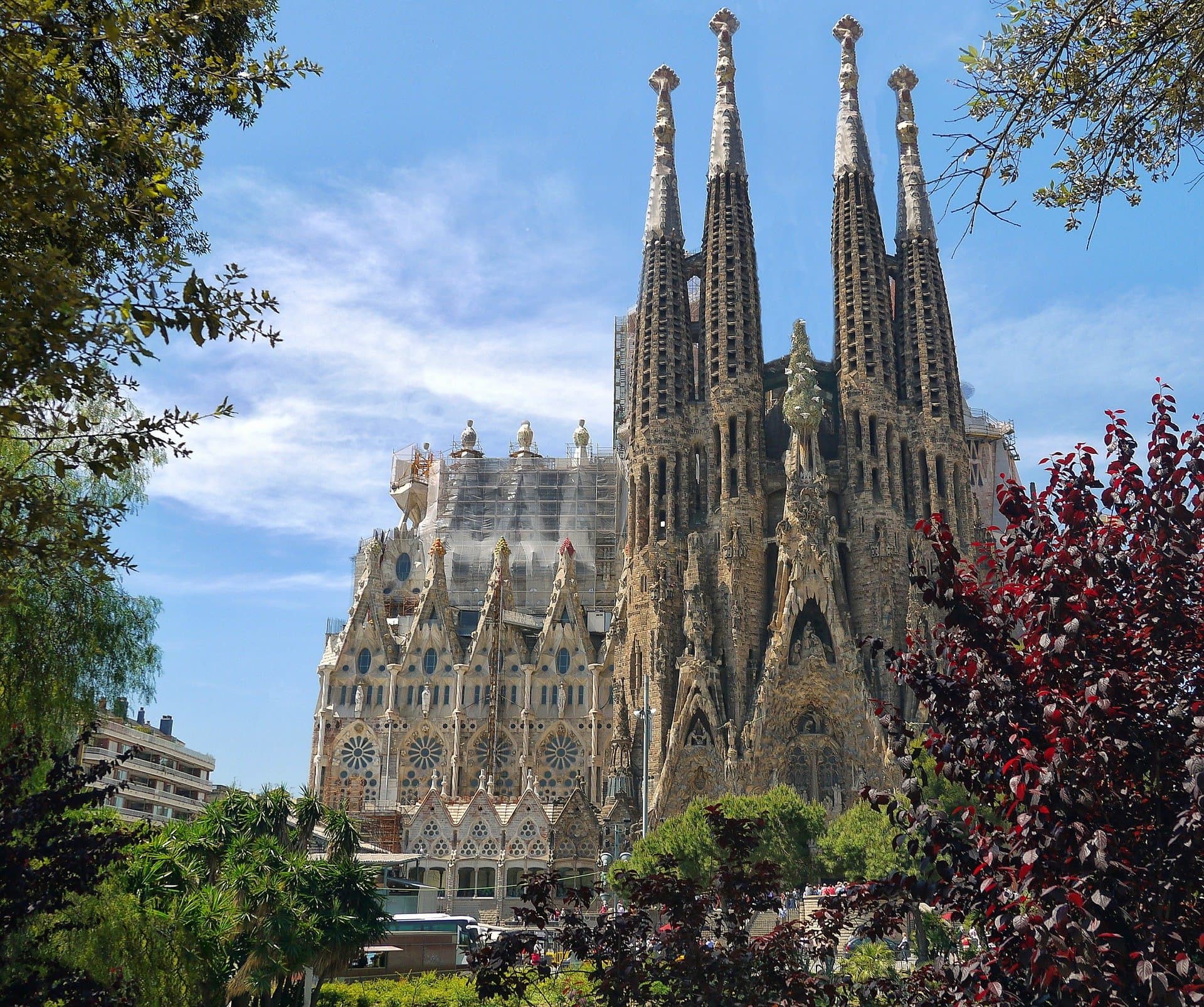
The Sagrada Familia, an iconic basilica designed by the renowned architect Antoni Gaudí, is a masterpiece that has captivated visitors for decades. Its unique blend of Gothic and Art Nouveau styles makes it one of the most recognizable landmarks in Barcelona and a symbol of the city's rich cultural heritage.
As construction continues more than a century after its inception, the Sagrada Familia reveals an ever-evolving story of architectural innovation and artistic vision. Discover Fascinating Facts about Sagrada Familia in Barcelona, Spain! From its intricate facades to the symbolism woven into every detail, this monument offers a profound glimpse into Gaudí's genius and the history of Catalonia.
Unveiling the Architectural Marvel: Sagrada Familia's Unique Design Elements
The Sagrada Familia stands as a testament to the innovative architectural design of Antoni Gaudí, characterized by its organic forms and profound connection to nature. Gaudí's vision led to the incorporation of hyperboloid structures and catenary arches, which not only provide structural integrity but also create an awe-inspiring visual experience. This unique approach allows the basilica to blend seamlessly with its surroundings, making it a living part of the landscape.
One of the most striking features of the Sagrada Familia is its intricate facades. Each side of the basilica tells a different story, rich with symbolism and artistry. The Nativity Facade, for example, celebrates the birth of Christ through detailed sculptures and vibrant colors, while the Passion Facade contrasts this with stark, angular forms that evoke a sense of solemnity. Visitors can explore these narratives through the use of natural light filtering through stained glass windows, enhancing the emotional impact of the architecture.
The basilica's interior is equally impressive, featuring tree-like columns that rise to support the ceiling, creating an enchanting forest-like atmosphere. Gaudí's use of geometry and light transforms the space into a vibrant and dynamic environment, reflecting his belief that architecture should emulate the forms found in nature. This design not only serves aesthetic purposes but also enhances acoustics, making it a perfect venue for music and worship.
Finally, the ongoing construction of the Sagrada Familia reflects a commitment to Gaudí's original vision, integrating modern techniques while preserving the artistic integrity of the design. This remarkable blend of the past and present ensures that the basilica remains a vital part of Barcelona's architectural landscape for future generations. Visitors are encouraged to marvel at the dedication and creativity evident in every detail, from the sculptural elements to the innovative use of materials.
The Historical Significance of Sagrada Familia: A Journey Through Time
The Sagrada Familia is not just an architectural wonder; it is a historical monument that embodies the artistic evolution of Barcelona over the decades. Its construction began in 1882, and since then, it has become a symbol of the city's identity and a reflection of the Catalan cultural renaissance. As styles and techniques evolved, the basilica became a canvas for innovation, attracting architects and artisans who contributed to its intricate design.
Throughout its history, the Sagrada Familia has faced numerous challenges, including interruptions due to the Spanish Civil War and funding issues. Despite these obstacles, the project has always been met with a relentless drive to complete Gaudí's vision. Today, the basilica is a UNESCO World Heritage Site, recognized for its unique architectural significance and rich history, drawing millions of visitors who come to marvel at its beauty and learn about its storied past.
In addition to being a religious site, the Sagrada Familia represents a journey through the evolution of architecture and design. The basilica is characterized by its fusion of styles, combining elements of Gothic and Art Nouveau in a way that had never been seen before. This blend is not merely aesthetic but serves to tell the story of Barcelona’s resilience and creativity, making it an enduring symbol of hope and inspiration.
As construction continues, each new element added to the Sagrada Familia pays homage to Gaudí's original vision while incorporating modern engineering techniques. This ongoing development is a testament to the dedication of the architects and builders who strive to fulfill the dream of completing a masterpiece that will stand the test of time. The Sagrada Familia is truly a living history, showcasing not just the artistry of Antoni Gaudí but also the collaborative spirit of generations past and present.
Exploring the Symbolism Behind Sagrada Familia's Colorful Facades
The colorful facades of the Sagrada Familia are not only visually stunning but also rich in symbolism. Each hue and design element has a purpose, reflecting the spiritual journey and beliefs embedded in Gaudí's vision. The use of color plays a significant role in conveying narratives, enhancing the viewer's emotional experience as they engage with the basilica's architecture.
One of the most significant aspects of the facades is their connection to nature, which Gaudí deeply admired. The vibrant colors mimic the changing seasons, creating a dynamic interplay of light and shade. This design choice emphasizes the idea that the Sagrada Familia is not just a building, but a living entity that evolves with time. Key elements include:
- Natural Shades: Greens and browns represent growth and life.
- Warm Tones: Reds and yellows symbolize warmth and spirituality.
- Cool Colors: Blues and purples evoke tranquility and reflection.
The Passion Facade, in stark contrast, employs angular forms and muted colors to evoke a sense of sorrow and reverence. This facade tells the story of Christ's crucifixion, with its dramatic features designed to provoke contemplation. The emotional intensity of the colors and shapes invites visitors to reflect on deeper themes such as sacrifice and redemption.
In addition to the emotional narratives, the interplay of light within the Sagrada Familia further enhances its facades. As sunlight filters through the stained glass, it creates a kaleidoscope of colors that dance across the interior spaces. This integration of light and color serves to reinforce the primary message of Gaudí’s work: the importance of nature and spirituality in human experience.
Must-See Features of Sagrada Familia: Iconic Elements You Can't Miss
The Sagrada Familia is adorned with towering spires that reach towards the heavens, an iconic feature that cannot be missed. Each of the 18 spires represents a different religious figure, including the Virgin Mary and the apostles. The central spire, dedicated to Jesus Christ, will stand at an impressive height of 172.5 meters, making it the tallest church building in the world upon completion. This verticality not only symbolizes the spiritual aspirations of the basilica but also serves as a stunning visual anchor in Barcelona’s skyline.
Another must-see feature is the intricate sculptures that embellish the facades. These carvings are rich in detail and are meant to convey biblical stories and themes. The Nativity Facade, for instance, is decorated with scenes depicting the birth of Jesus and is characterized by its organic shapes and lively figures. Visitors should take a moment to appreciate the symbolism embedded within these sculptures, which reflect Gaudí’s deep connection to nature and spirituality.
Inside the basilica, the stained glass windows are a breathtaking highlight. The vibrant colors of the glass transform the interior spaces as sunlight streams through, creating an ethereal atmosphere that enhances the overall experience. These windows are not merely decorative; they also serve to narrate the life of Christ and evoke emotional responses. The interplay of light and color is designed to inspire awe and reflection among visitors, making it an essential aspect of the Sagrada Familia's interior.
Finally, the crypt of the Sagrada Familia is a hidden gem worth exploring. It is the burial place of Antoni Gaudí himself and houses various models and sketches that illustrate his visionary approach to architecture. The crypt's humble yet significant presence serves as a reminder of Gaudí's dedication to this monumental project and his enduring legacy. Each of these features contributes to the rich tapestry of the Sagrada Familia, making it an unforgettable destination for anyone visiting Barcelona.
Sagrada Familia: A Testament to Gaudí's Vision and Creativity
The Sagrada Familia is not only a symbol of Barcelona but also a testament to Antoni Gaudí's extraordinary vision and creativity. His approach to architecture was deeply intertwined with his beliefs about nature and spirituality, which is vividly reflected in the basilica's design. Gaudí believed that buildings should mimic the forms and patterns found in the natural world, leading him to create structures that are both functional and visually striking. The basilica’s sprawling, organic shapes resemble a forest, where columns soar like trees, emphasizing the connection between architecture and the environment.
One of the most remarkable aspects of Gaudí's design is the incorporation of symbolism throughout the Sagrada Familia. Each element serves a purpose beyond mere aesthetics; they tell stories and convey deeper meanings. For example, the number of spires, the intricate carvings, and even the choice of materials are all intentional, representing various aspects of Christianity and the natural world. Gaudí's work encourages visitors to engage with the basilica on multiple levels, inviting them to explore not only its beauty but also its profound narratives.
The ongoing construction of the Sagrada Familia, which began in 1882, showcases a blend of traditional craftsmanship and modern technology, ensuring that Gaudí's original vision is preserved. With a projected completion date of 2026, the project continues to attract skilled artisans and architects who are dedicated to maintaining the integrity of Gaudí's design. This commitment has transformed the basilica into a collaborative effort, with each new phase of construction building upon the collective creativity of many generations.
In conclusion, the Sagrada Familia serves as an enduring reminder of Gaudí's genius and a reflection of his innovative approach to architecture. Its grandeur, coupled with its intricate symbolism and ongoing development, makes it a true masterpiece that continues to inspire awe in all who visit. This architectural wonder not only captivates the eye but also resonates with the soul, embodying a vision that transcends time and speaks to the human experience.
Visiting Sagrada Familia: Tips for an Unforgettable Experience in Barcelona
Visiting the Sagrada Familia is a unique experience that requires some planning to ensure you make the most of your time. One of the best tips is to book your tickets online in advance to avoid long queues. Consider choosing a time slot early in the morning or later in the afternoon when the crowds are typically smaller. This will allow you to explore the basilica at your own pace and fully appreciate its breathtaking architecture.
To enhance your visit, take advantage of the audio guides available on-site, which provide insightful commentary on Gaudí's design and the basilica's history. Alternatively, consider joining a guided tour for a more in-depth experience. Make sure to allocate time to admire not only the exterior facades but also the stunning interior spaces, where the interplay of light through stained glass creates a magical ambiance.
While at the Sagrada Familia, don't forget to visit the towers for spectacular views of Barcelona. Climbing to the top provides a unique perspective of the city and an opportunity to see the intricate details of Gaudí's work from above. It's an experience that truly encapsulates the basilica's grandeur and its place in the skyline of Barcelona.
Lastly, take a moment to reflect in the nearby Parc de la Ciutadella or the Plaza de Gaudí, where you can relax and enjoy the view of the Sagrada Familia from a distance. These spots provide a perfect backdrop for photos and a chance to appreciate the basilica's impressive presence in a more tranquil setting. Planning your visit with these tips in mind will ensure an unforgettable experience at this architectural marvel.
 Sagrada Familia Barcelona: 10 Fascinating Facts About Gaudí's Masterpiece
Sagrada Familia Barcelona: 10 Fascinating Facts About Gaudí's MasterpieceIf you want to know other articles similar to Discover Fascinating Facts about Sagrada Familia in Barcelona, Spain! you can visit the category WHERE YOU CAN GO.
Leave a Reply










Read more!